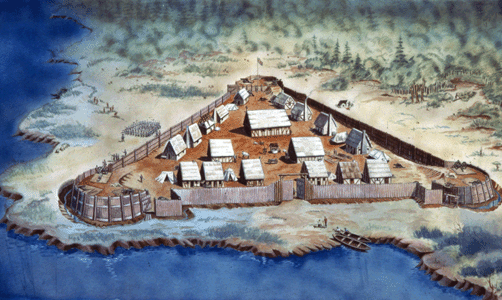May 2-8, 2013, Current Events Lesson Plan
Current Event:
Forensic anthropologists recently unveiled proof that the colonists of Jamestown (in what is now Virginia) resorted to cannibalism to survive the terrible winter of 1609-1610. Jamestown’s population dropped from about 250 to 60 during this so-called “Starving Time.” Written records describe how the desperate colonists ate horses, cats, dogs, rats, and even shoe leather. Historians have long known of some accounts that hinted at cannibalism by the colonists. But without physical proof, many scholars dismissed the accounts. In 2012, archaeologists excavated the skull of a young girl from a trash-filled corner of historic Jamestown. On the skull, they saw telltale cuts and other damage indicating that the girl’s body was crudely butchered to be eaten. Smithsonian scientists speculate that she may have been one of many colonists who arrived in 1609 and later died of starvation or disease.

Jamestown, on the James River in what is now Virginia, was founded in 1607 by a group of colonists from England. The settlers built a triangular fort to protect them from Indians. © Hulton Archive/Getty Images
Objective:
Jamestown, Virginia, was the first permanent English settlement in North America. In 1607, three ships arrived from London with 104 colonists and 39 sailors. The colonists established themselves on a peninsula about 60 miles (97 kilometers) from the entrance of the Chesapeake Bay. They settled in a region ruled by a powerful chief named Powhatan, who built the Powhatan Confederacy of tribes. During the summer and fall of 1607, a combination of disease, periodic Indian attacks, bad drinking water, and poor diet led to many deaths. By the winter, fewer than 40 of the original colonists who arrived at Jamestown survived. In 1608 and 1609, several hundred more colonists arrived in Jamestown. In 1609, war broke out between the colonists and the Indians. In the winter, the Powhatans sealed off Jamestown in an effort to starve the colony into submission. During the siege, later called by colonists the “Starving Time,” Jamestown’s population dropped from about 250 to 60. Only the arrival in June 1610 of Governor Thomas West, Lord De La Warr, with 150 settlers saved the settlement from abandonment. John Rolfe, one of Jamestown’s settlers, began to raise tobacco in 1612. The enormous expansion of the tobacco trade during the 1600’s guaranteed Jamestown’s importance as a port and market. Jamestown’s prosperity came to an abrupt halt when the town burned to the ground in 1676 during Bacon’s Rebellion. Fire again destroyed many of the principal buildings in 1698. The latter disaster led to Jamestown’s eventual fall into decay. The Behind the Headlines news story and related World Book articles explore Jamestown and colonial America.
Words to know:
- Bacon’s Rebellion
- Cannibal
- Chesapeake Bay
- Colonial life in America
- Colony
- Forensic Anthropology
- History of the United States
- Jamestown
- Pocahontas
- Powhatan
- John Rolfe
- John Smith
- Smithsonian Institution
- Virginia (History)
Discussion Topics:
1. Ask your students what they know about colonial America. (Students might say that there were 13 colonies; many colonists came for economic or religious reasons; the colonists periodically had wars with the Indian tribes that already lived in America.)
2. Ask your students if they would rather have lived in colonial America or in the present time.
3. Ask your students to debate, “It is important to study history.”
4. Ask your students to use the World Book’s Timelines feature to create a timeline of the history of colonial America. (Students may wish to use the “The American Colonies (1707-1753)” section of World Book’s History of the United States article for help.)


